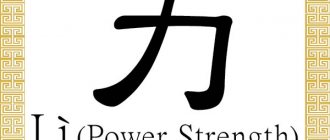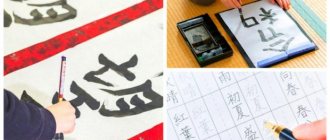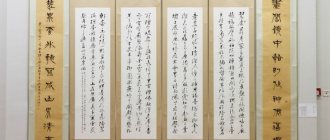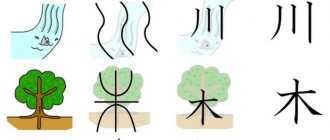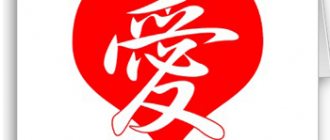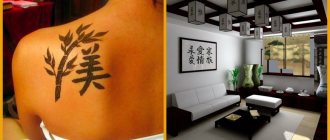Chinese characters are the characters used to write in Chinese and Japanese. In the past, other languages, such as Korean and Vietnamese, also used Chinese characters. In Chinese they are called Hanzi, which means "Han characters". They are called kanji in Japanese, hancha in Korean, and Zhuang in Vietnamese.
Chinese characters are the oldest form of writing in the world that is still in use today. In addition, Chinese characters are one of the most common writing systems in the world in terms of the number of users.
Chinese characters are also an important part of East Asian culture. The art of writing Chinese characters is called calligraphy.
Calligraphy is the art of writing, which means “beautiful writing” in Greek. East Asian calligraphy was a "high art" form and continues to have a high status among the arts. But in the Western world, calligraphy has always been considered an insignificant art.
There are several tens of thousands of Chinese characters; no one knows exactly how many there actually are. But if we take into account the principle of their composition, then there can be an infinite number of hieroglyphs. However, research shows that between three and four thousand characters are commonly used in everyday life.
The Kangxi Zidian (康熙字典) dictionary, created during the Qing Dynasty, contains 47,035 characters. The Great Chinese-Japanese Dictionary (大汉和字典) contains 48,902 characters. Taiwan's Zhongwen Da Zidian (中文大字典) contains 49,905 characters. Chinese Hanyu Da Zidian (汉语大字典) contains 54,678 characters. The largest dictionary of Chinese characters, compiled in 1994, Zhonghua Zihai (中华字海) contains 85,568 characters. The Japanese dictionary “Nihon konjaku mojikyo” (日本今昔文字鏡) contains the largest number of hieroglyphs at this time - 150 thousand.
The words of ancient Chinese were mostly monosyllabic, with each character representing one word. In modern Chinese, most Chinese words consist of two or more characters. A symbol almost always corresponds to one syllable.
Modern Chinese has many homophones, so the same spoken syllable can be represented by many characters, depending on the meaning.
A homophone is a word that is pronounced the same as another word but has a different meaning.
One hieroglyph can also have a range of meanings, or sometimes quite different meanings; sometimes they correspond to different pronunciations.
What is a hieroglyph
Hieroglyphs are signs that are used in several countries for writing. One hieroglyph can represent 1 letter, syllable, word or even a phrase. The meaning of a word will also depend on the tone in which it is spoken.
The very concept of “hieroglyph” began to be used even before our era. If we translate its origin, it means “sacredly carved letters.”
Writing instruments
The first writing tool in ancient China was a sharp object used to make lines. In order for them to appear on the material on which they are applied, its surface had to be smooth and soft enough. In pottery production, clay was used for these purposes. Animal bones and turtle shells were also used. For better visibility, the scratched lines were filled with black dye. All of the above components are a certain stage in the development of writing and form the environment for the emergence of real linguistic units.
History of origin
All Chinese hieroglyphs can be divided into two types of characters: zi (composite characters) and wen (simple characters, the most ancient).
Chinese scientists claim that hieroglyphs were preceded by a letter of special knotted characters. The creator of the first hieroglyphs was Tsang Jie. When writing symbols to designate objects or actions, he carefully watched them and studied their characteristics. The author of the first symbols served as a historiographer for Emperor Huang Di. He was so wise and perspicacious that he was often depicted with 4 eyes. Historians claim that of all the proposed signs for writing, only this one was accepted for use.
If we take into account the appearance of the first hieroglyphs, they are older than the cuneiform writing of the Sumerians. The first Chinese characters appeared in the 2nd millennium BC. Inscriptions similar to hieroglyphs were depicted on bones and scratched into stone. They were applied with pointed sticks. The first pictograms that were invented denoted actions, parts of the human body and natural phenomena, and accessories for household use.
New rules for writing hieroglyphs were introduced during the Zhou era. This is a court historiographer who compiled a list of the most used symbols in the 8th century BC. Writing new characters has become more difficult. At the same time, phonoideograms were introduced - signs that consisted of 2 parts: phonetic (it indicated how to pronounce correctly) and what class the object or its properties belonged to. In contrast to these hieroglyphs, modern ones are classified as ideograms.
In the Zhanguo era, hieroglyphic writing was divided into several variants, depending on the region in which it was used. Emperor Qin Shi Huang tried to create a single letter for all of China. The "official" script he introduced became the basis for modern Chinese. The dictionary of that time recorded up to 3,400 hieroglyphs that were used by the people.
At the beginning of the 20th century, hieroglyphic writing became so complex that one sign could have up to 20 lines. The authorities decided to simplify their writing a little. This issue was returned to in the 1930s and in 1956. Today, Chinese symbols are not only part of the Chinese script, but also signs that have secret meanings and sometimes magical properties.
Interview with lecturer
— What attracts you, a specialist in historical linguistics, specifically in the Chinese language?
— First of all, the historical aspect. In its features, the Chinese language is extremely different from typical European languages, but at the same time it is also terribly lucky compared to its neighbors in Southeast Asia. It has a three-thousand-year written history, recorded in such a gigantic array of texts that there will be enough complex, contradictory, unresolved issues for another hundred years to come, if not more. Consider, for example, the question of how to restore the sound of ancient Chinese texts, which in hieroglyphs was never directly reflected in writing!
— How did you start studying hieroglyphs?
— In addition to purely theoretical reasons, there were also personal ones: I owe a lot to at least three wonderful people, two of whom, unfortunately, are no longer alive, that I teach classical Chinese today and practice it professionally. This is my father and teacher Sergei Anatolyevich Starostin, who himself was engaged in Chinese reconstruction and etymology; my Chinese teacher Grigory Aleksandrovich Tkachenko is a man with a completely unique scientific vision, the author of numerous studies and translations in the field of Chinese culture and philosophy. Both of them taught by personal example the most important thing - how to overcome the abstract fear of such a gigantic monster as Chinese civilization, and calmly approach its study from a modern, logical, methodologically correct position. And finally, of course, the director of the Institute of Oriental Cultures and Antiquity, where I work, had and continues to have a great influence on me, Ilya Sergeevich Smirnov - an excellent expert on Chinese culture and poetry, who knows how to speak in lectures, in books, and in personal conversations. bring this culture to life like no other.
— What place does the subject of your scientific interest occupy in the modern world?
— Hundreds of millions of Chinese and Japanese today use hieroglyphic writing in their daily lives - what’s more, the very word “hieroglyph” (wen) in the Chinese language long ago acquired such secondary meanings as “written text”, “literature”, “culture” ", "civilization", that is, the main thing that distinguishes a cultured, civilized person from a barbarian.
But at the same time, the deeper you dig, the more you solve old questions, the more new ones arise. Almost every few years, Chinese archaeologists excavating ancient burials discover more and more written monuments, so today we know much more about hieroglyphics than the most famous medieval Chinese sages knew.
— If you needed to quickly interest a stranger in Chinese characters, how would you do it?
- , no action from the outside is required here: the Far Eastern written culture, be it in the form of a sign on a Japanese restaurant, or even in the form of a manga comic (by the way, in terms of popularizing hieroglyphic culture, Japan is, of course, far ahead of China), today in the public eye with very early age. And the task of a professional is to prevent a person from becoming confused, confused, or afraid of the excessive complexity of hieroglyphic culture. It is important to show very quickly that this culture actually obeys certain, completely natural and logical laws; that in order to master it, you do not need to memorize fifty thousand independent pictures-hieroglyphs, but you only need to understand the simple principles by which the complex in this culture is built from the simple.
— Can you tell us about the strangest thing you encountered while reading sources?
“Many stories are connected with individual private absurdities that have been passed down from teacher to student for centuries only because they mistakenly put one hieroglyph in the text instead of another. The Chinese, by the way, understood this themselves for a very long time. In another text written before our era, there is an anecdote about how he spent a long time agonizing over a manuscript, trying to understand the sentence “The general crossed the river with three pigs,” until it was pointed out to him that in this place it was actually written illegibly “ The commander crossed the river on the day of the Ji-hai calendar.” The authority of the elder in traditional (and also in modern) China is an almost impenetrable thing. Alas, it is human nature to make mistakes, and for a researcher of Far Eastern culture the most important thing today is to learn to combine respect for tradition with a competent critical attitude.
Which countries use hieroglyphs?
Today, many people use hieroglyphs for writing, mainly in Asian countries. All modern characters are of Chinese origin, but with the addition of local flavor.
So, besides the Chinese, they use hieroglyphs in Japan, Korea, Vietnam, Singapore and Malaysia. Hieroglyphs are also used by some peoples in Mongolia. By the way, Koreans replaced their hieroglyphs with a phonetic script called Hangul.
How to distinguish hieroglyphs from different countries?
Literature of Ancient China
The literature of Ancient China is the oldest in the world. The hieroglyphs preserve the shadow of the pristine and immutable Chinese culture, its spirituality and wealth. The works of literature of Ancient China are the heritage of world culture, although they are as complex for our perception as the Chinese language itself.
One of the first Chinese treatises is the Book of Changes.
It has the same meaning to the Chinese as the Bible does to us. An ancient legend says that the hexagrams from this book were written on the shell of a gigantic turtle that once appeared on the surface of the sea.
How many characters are there in Chinese?
Even a professional sinologist cannot tell the exact number of hieroglyphs (up to one). If you take the most complete dictionary of Chinese characters for writing, then there will be more than 50,000 of them. The most complete dictionary of hieroglyphs, which was presented over the past few hundred years, contained almost 86 thousand characters, but almost a third of them are used by ordinary Chinese not used. Some of them were used either only in classical literature, or have not been used for a long time.
During the Middle Ages, it was not uncommon for philosophers and writers to create new hieroglyphs. Because of this, new signs began to appear, which only “clogged” the language. Some of them just didn't make sense. This prompted the authorities to ban the uncontrolled creation of hieroglyphs.
Today, the acceptable level of minimum literacy depends on what a Chinese person does. So, for ordinary peasants it is enough to own 1.5 thousand hieroglyphs. Employees and workers must know at least 2 thousand characters. If a child graduates from school, he must know 4 thousand hieroglyphs. This is enough for communicating with people, reading and understanding books and the press. Those who engage in mental work must know at least 6 thousand characters. If, after passing the test, it turns out that a person speaks only 900 characters or less, then he belongs to the illiterate part of the population. If a citizen of another country wants to master Chinese and pass an exam on his knowledge, he must master up to 3 thousand characters.
Where to find out more
Olga Zavyalova. "The Big World of Chinese" (2014)
There are practically no publications in Russian that seriously and clearly talk about how the Chinese language works, its history, dialects and writing - all the more significant for the reader will be this publication, prepared by one of the best domestic specialists in Chinese dialectology. From it you can learn about how literary Chinese differs from spoken Chinese, and about why hieroglyph dictionaries were compiled in traditional China, and a lot of other useful information. The book will be useful not only to those who are already learning the language, but also to those who are still wondering whether it is worth learning it.
Mikhail Sofronov. "Chinese language and Chinese writing" (2007)
Mikhail Viktorovich Sofronov is the largest Russian specialist in the history of the Chinese language and the Southeast Asian linguistic area. The book is a revised course of lectures, somewhat more specialized than Zavyalova’s work, but still, in my opinion, understandable to a person who has never studied Chinese. There is a lot of information here not only about the Chinese language itself, but also about other languages spoken both in China and in neighboring territories.
Lyudmila Fedorova. "History and Theory of Writing" (2015)
Any object is understood only in the context of similar ones - therefore, in order to better understand the specifics of Chinese and Japanese hieroglyphic writing, basic information about them should be obtained along with information about other writing systems. From Lyudmila Fedorova’s textbook, which contains the most relevant and modern information about the written systems of the world’s languages, you can, for example, find out how Chinese characters are similar to Egyptian ones (from which almost all European writing systems known to us ultimately developed), and how, on the contrary, , are radically different from them.
Prose of Ancient China
Chinese prose began with the presentation of historical events and facts. She was greatly influenced by Buddhism and the works of Indian storytellers. It is not for nothing that the first genre of Chinese prose was chuanqi - stories of miracles. The first collection of ancient Chinese prose was “Notes on the Search for the Spirits of Gan Bao,” written in the 4th century. The latest and at the same time the most successful is “Liao Zhai's Tales of the Miracles of Pu Song Ling,” collected in the 17th century.
The Ming period is considered the peak of the development of ancient Chinese prose. This is the time of fascinating democratic stories of Huaben, which are so loved by people of all walks of life for their sincerity, truthfulness and excitement.
In the 15th century, the genre of the novel began its ascent to the literary Olympus. In Ancient China, the following genre directions were distinguished: historical, adventure, everyday, critical, romance and fantasy.
Due to the absence of the theory of anthropocentrism in the Chinese consciousness, there are no epics in the literature of Ancient China. What is beautiful in the Chinese understanding is harmony, based on the interaction of nature and society; this concept is in no way connected with the personality of an individual person.

